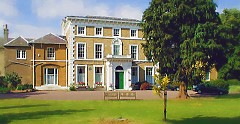|
A comfortable 1930s suburban locality lying on a westerly slope beside the Pymmes Brook west of Southgate. Its name (which
is pronounced to rhyme with ‘sausage’) comes from the Old English, meaning ‘hedge belonging to a man named
Osa’. Osidge was first recorded in 1176, in a charter from Henry II to the Abbot of St Albans referring to the abbot’s
woodland property here, where pigs were kept. The land was sold off after the dissolution of the monasteries and a substantial
house was erected and parkland laid out. A condition of tenure was that the woods should supply faggots for the burning of
heretics. In 1652 the house became the residence of local notables the Hadley family. John Kingston of Oak Hill built a new
Osidge in 1808, and promptly sold it. From 1893 this was the home of Thomas Lipton, who had been born into poverty in Glasgow
and created a national chain of grocery stores. He is best remembered for his blends of tea, and for popularising the beverage
in the USA. After his death in 1931 most of the 60-acre estate was built up, but Lipton endowed his home as a hostel for nurses.
The house still stands (see the picture below), in five acres of grounds at 151 Chase Side, near the corner of Osidge Lane,
which was originally called Blind Lane. Hugh Davies, the developer of the Osidge estate advertised the proximity of Southgate
station with a paraphrase of a popular song: “Home, James, and don’t spare the horses, it’s a home on the
Tube for me.” The properties are mostly semi-detached, with generous gardens. To the west, the attractive but under-let
Hampden Square has shops, restaurants and the Osidge Arms.
 |

